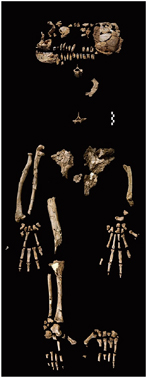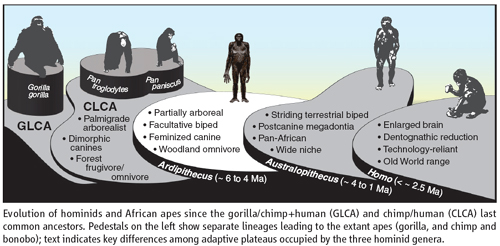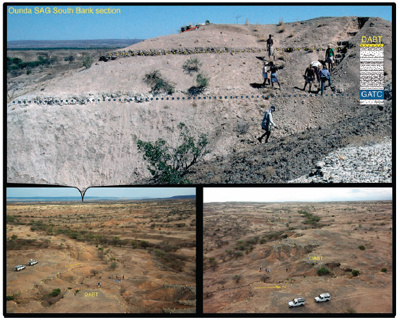Devaneios evolutivos…
 Esta imagem/post, retirado e mais do que partilhado pela página de Facebook “I fucking love science” é uma excepção às suas excelentes e divertidas imagens-mensagem.
Esta imagem/post, retirado e mais do que partilhado pela página de Facebook “I fucking love science” é uma excepção às suas excelentes e divertidas imagens-mensagem.
E porquê?
1 “You are the result of 3.8 billion years of evolutionary success”
O aparente topo evolutivo ocupado pelo ser humano, de alguma forma reflectido no texto desta imagem, não é verdadeiro, já que a nossa espécie é um acaso da História Evolutiva da vida na Terra.
Ao contrário do que está implícito, a Evolução da vida não tem o ser humano como o pináculo evolutivo, o seu porto de chegada, o seu mais perfeito representante, o final do caminho da vida sobre a Terra, isto apesar da nossa existência actual ser fruto de um sem número de sucessos intermédios.
Seremos tão pináculo evolutivo da História da Terra como outros seres vivos actuais – representantes no presente de várias linhagens de seres vivos que singraram ao longo do tempo.
2 Outra mensagem que poderá induzir em erro, e subjacente neste texto, é que a Evolução é sinónimo de um cada vez maior aperfeiçoamento e complexidade dos organismos, sendo o representante deste conceito nesta imagem/texto o ser humano.
Isto não é de todo verdade.
Embora existam casos de incremento de complexidade, a Evolução conduz* também a redução de complexidade biológica, à diminuição de estruturas, entre outras alterações morfológicas e/ou fisiológicas.
Evolução biológica não é sinónimo de maior complexidade – pode ou não sê-lo.
3 Ainda outra mensagem subjacente é a de cariz moral/comportamental. Devemos actuar em função do sucesso obtido pelos nossos antepassados, sejam eles mais ou menos distantes.
O que não me agrada nesta mensagem é a mistura entre sucesso evolutivo e a matrizes de comportamento moral/ético. Isto talvez possa justificar parte do sucesso evolutivo recente dos nossos antepassados, mas não justifica a esmagadora maioria do tempo geológico.
O singrar de um organismo e o sucesso de um código de conduta, embora possam estar interligados, são questões distintas, sendo perigoso generalizá-los.
Se nos focarmos no comportamento humano e na diversidade de valores éticos e morais existentes, então estaremos de certeza a misturar alhos com bugalhos quando afirmamos que nos deveremos comportar em função do sucesso biológico de um passado tão longínquo como o de há centenas ou milhares de milhões de anos.
Apenas alguns devaneios evolutivos…já há muito debatidos e analisados por outros muito melhores do que eu.
* a utilização deste vocábulo é exagerada, sendo aqui utilizada por simplificação na leitura.
No final é só o que resta
 No final é só o que resta.
No final é só o que resta.
Afinal desde o começo que já cá estava.
Apenas levemente suspensa, pela outra.
Mas sempre presente.
A única companheira.
No arrastar dos dias, tapada entre outras neblinas, é a única certeza.
Ou quase.
Olhamos o céu, o mar, ou espelho, e ei-la.
Julgamo-nos maiores que ela porque a pensamos e reconhecemos.
Maiores que todas as vidas que nos rodeiam e que temporariamente a encobrem.
Sozinhos com ela.
![]()
“(..) workers of the ant Temnothorax unifasciatus dying from fungal infection, uninfected workers whose life expectancy was reduced by exposure to 95% CO2 and workers dying spontaneously in observation colonies exhibited the same suite of behavior of isolating themselves from their nestmates days or hours before death. Actively leaving the nest and breaking off all social interactions thus occurred regardless of whether individuals were infected or not. Social withdrawal might be a commonly overlooked altruistic trait serving the inclusive fitness interests of dying individuals in social animals.”
«”When Pansy lay down in a nest that one of the other apes had made, the rest gathered around her and began grooming and caressing her. Shortly before she died, all three crouched down and inspected her face very closely. They then began to shake her gently. “It is difficult to avoid thinking that they were checking for signs of life,” said Anderson.
“After a time, it seemed that the chimpanzees arrived at a collective decision that she had gone. Two left immediately, but one, the other adult female, stayed and held her hand,” said Anderson.»
Referências:
Heinze, J., & Walter, B. (2010). Moribund Ants Leave Their Nests to Die in Social Isolation Current Biology, 20 (3), 249-252 DOI: 10.1016/j.cub.2009.12.031
Imagem:
Magdalen of the night light, Georges de La Tour
Ardipithecus ramidus
 Um dia a recordar, o de hoje, em que foi publicada mais uma página da história da evolução do Homem.
Um dia a recordar, o de hoje, em que foi publicada mais uma página da história da evolução do Homem.
Ardipithecus ramidus, assim baptizado, vem iluminar o caminho da compreensão do nosso percurso biológico no planeta.
Deixo apenas algum material gráfico, bem como o resumo do artigo.
“Hominid fossils predating the emergence of Australopithecus have been sparse and fragmentary.
The evolution of our lineage after the last common ancestor we shared with chimpanzees has therefore remained unclear. Ardipithecus ramidus, recovered in ecologically and temporally resolved contexts in Ethiopia’s Afar Rift, now illuminates earlier hominid paleobiology and aspects of extant African ape evolution. More than 110 specimens recovered from 4.4-million-year-old sediments include a partial skeleton with much of the skull, hands, feet, limbs, and pelvis.
This hominid combined arboreal palmigrade clambering and careful climbing with a form of terrestrial bipedality more primitive than that of Australopithecus. Ar. ramidus had a reduced canine/ premolar complex and a little-derived cranial morphology and consumed a predominantly C3 plant-based diet (plants using the C3 photosynthetic pathway). Its ecological habitat appears to have been largely woodland-focused. Ar. ramidus lacks any characters typical of suspension, vertical climbing, or knuckle-walking. Ar. ramidus indicates that despite the genetic similarities of living humans and chimpanzees, the ancestor we last shared probably differed substantially from any extant African ape. Hominids and extant African apes have each become highly specialized through very different evolutionary pathways. This evidence also illuminates the origins of orthogrady, bipedality, ecology, diet, and social behavior in earliest Hominidae and helps to define the basal hominid adaptation, thereby accentuating the derived nature of Australopithecus.”


Referências:
Tim D. White, et al. 2009. Ardipithecus ramidus and the Paleobiology of Early Hominids. Science 326, 64. DOI: 10.1126/science.1175802
Imagens:
do artigo








